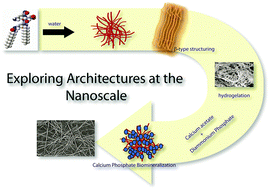Exploring architectures at the nanoscale: the interplay between hydrophobic twin lipid chains and head groups of designer peptide amphiphiles in the self-assembly process and application†
Abstract
The self-assembly of peptide amphiphiles (PAs) is found to be governed by the hydrophobic interactions induced by the hydrophobic groups/number of alkyl chains and the hydrophilic head groups. In this study, an assessment of the nanostructures formed by the self-assembly of simple twin chained PAs was carried out and compared to their single chain/short analogues. The spectroscopic and microscopic analysis revealed the fact that the twin chained amphiphiles had a high inclination to form β-sheet nanofibers and further towards hydrogelation. The mixture of twin chained PAs also exhibited cooperative self-assembly with improved aggregation behavior, although not much augmentation in β-type structuring was found. In contrast, the single chain/short analogue containing PAs showed very less of β-sheet type structures to a lesser extent and no hydrogelating behavior but resulted in mostly random conformations. The increase in the number or alteration of polar head groups in double chained PAs induced higher extent of β-type conformation and better gelling capability due to the combined hydrophobic effect of the twin chains. The overall results delineated the dominance of hydrophobic interactions. Finally, calcium phosphate bio-mineralization was done in the hydrogels of twin chained PAs with the aim of developing future biomaterials.


 Please wait while we load your content...
Please wait while we load your content...